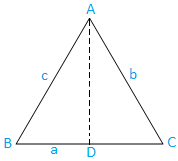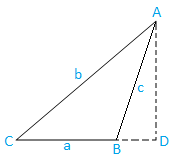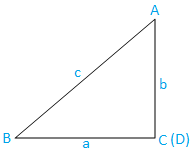Subscribe to our ▶️ YouTube channel 🔴 for the latest videos, updates, and tips.
Projection Formulae
Projection formulae is the length of any side of a triangle is equal to the sum of the projections of other two sides on it.
In Any Triangle ABC,
(i) a = b cos C + c cos B
(ii) b = c cos A + a cos C
(iii) c = a cos B + b cos A
Proof:
Let ABC be a triangle. Then the following three cases arises:
Case I: If ABC is an acute-angled triangle then we get,
a = BC = BD + CD ………………………… (i)
|
Now from the triangle ABD we have, cos B = BD/AB
⇒ BD = AB cos B ⇒ BD = c cos B, [since, AB = c] Again, cos C = CD/AC ⇒ CD = AC cos C ⇒ CD = b cos C, [since, AC = b] |
Now, substitute the value of BD and CD in equation (i) we get,
a = c cos B + b cos C
Note: We observe in the above diagram BD and CD are projections of AB and AC respectively on BC.
Case II: If ABC is an acute-angled triangle then we get,
a = BC = CD - BD ………………………… (ii)
|
Now from the triangle ADC we have, cos C = CD/AC
⇒ CD = AC cos C ⇒ CD = b cos C, [since, AC = b] Again, cos (π - B) = BD/AB ⇒ BD = AB cos (π - B) |
⇒ BD = -c cos B, [since, AB = c and cos (π - θ) = -cos θ]
Now, substitute the value of BD and CD in equation (ii) we get,
a = b cos C - (-c cos B)
⇒ a = b cos C + c cos B
Case III: If ABC is a right-angled triangle then we get,
a = BC ………………………… (iii)
|
and cos B = BC/AB ⇒ BC = AB cos B
⇒ BC = c cos B, [since, AB = c] Now, substitute the value of BC in equation (iii) we get, a = c cos B ⇒ a = c cos B + 0 |
⇒ a = c cos B + b cos C, [since C = 90° ⇒ cos C = cos 90 = 0]
Therefore, in any triangle ABC we get, a = b cos C + c cos B
Similarly, we can prove that the formulae b = c cos A + a cos C and c = a cos B + b cos A.
Solved problem using the projection formulae:
If the area of the triangle ABC be ∆, show that,
b\(^{2}\) sin 2C + c\(^{2}\) sin 2B = 4∆.
Solution:
b\(^{2}\) sin 2C + c\(^{2}\) sin 2B
= b\(^{2}\) 2 sin C cos C + c\(^{2}\) ∙ 2 sin B cos B
= 2b cos C ∙ b sin C + 2c cos B ∙ c sin B
= 2b cos C ∙ c sin B + 2c cos B ∙ c sin B, [Since, a/sin B = c/sin C ⇒ b sin C = c sin B]
= 2c sin B (b cos C + c cos B)
= 2c sin B ∙ a [Since, we know that, a = b cos C + c cos B]
= 4 ∙ ½ ac sin B
= 4∆. Proved.
- The Law of Sines or The Sine Rule
- Theorem on Properties of Triangle
- Projection Formulae
- Proof of Projection Formulae
- The Law of Cosines or The Cosine Rule
- Area of a Triangle
- Law of Tangents
- Properties of Triangle Formulae
- Problems on Properties of Triangle
11 and 12 Grade Math
From Projection Formulae to HOME PAGE
Didn't find what you were looking for? Or want to know more information about Math Only Math. Use this Google Search to find what you need.





New! Comments
Have your say about what you just read! Leave me a comment in the box below. Ask a Question or Answer a Question.